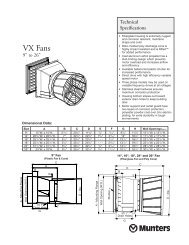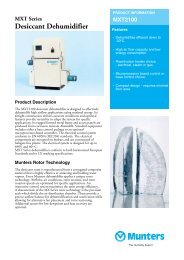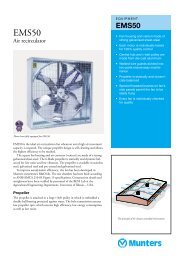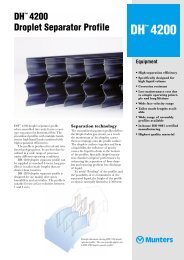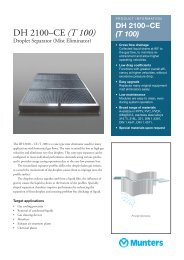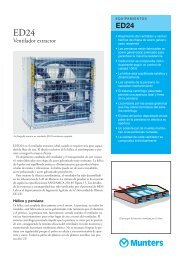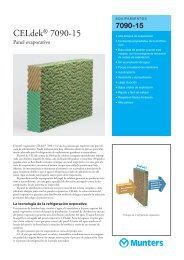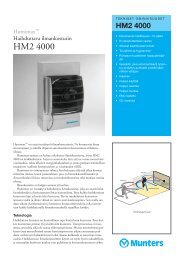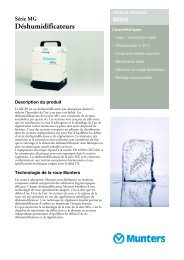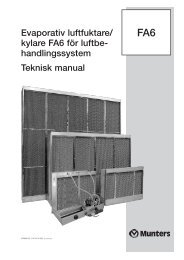Annual Report 2006 - Munters
Annual Report 2006 - Munters
Annual Report 2006 - Munters
You also want an ePaper? Increase the reach of your titles
YUMPU automatically turns print PDFs into web optimized ePapers that Google loves.
Average rateYear-end rateCurrency Country <strong>2006</strong> 2005 <strong>2006</strong> 2005AUD Australia 5.55 5.70 5.44 5.83CAD Canada 6.51 6.18 3.22 6.84CNY China 0.92 0.91 0.88 0.98DKK Denmark 1.24 1.25 1.21 1.26EUR Euro 9.25 9.28 9.05 9.43GBP United Kingdom 13.58 13.58 13.49 13.73JPY Japan 0.063 0.068 0.058 0.068NOK Norway 1.15 1.16 1.09 1.18SGD Singapore 4.64 4.49 4.49 4.79THB Thailand 0.19 0.19 0.19 0.19USD USA 7.38 7.48 6.87 7.95ZAR South Africa 1.10 1.17 0.99 1.262.4 Changed accounting principlesEffective 1 January <strong>2006</strong>, <strong>Munters</strong> changed its reporting of actuarial gains andlosses in accordance with the changes in IAS 19, Employee Benefits. Previousmethods implied that actuarial gains and losses, to the extent they fall outsidethe 10-percent corridor, are amortized over the average remaining employmentperiod for participants of the pension plan. As of 1 January <strong>2006</strong>, thealternative permitted by IAS 19 is applied, whereby all actuarial gains andlosses pertaining to benefits after termination of employment are reportedagainst equity, net after deferred tax, in the period that they occurred.Previous reporting periods have been recalculated in accordance with thenew principles. Special employer’s contributions in Sweden relating toactuarial gains/losses are reported under equity.The transition to the new principles resulted in pension provisions increasingnet by SEK 13 M as per 1 January 2005. Accrued expenses increased by SEK4 M and deferred tax assets increased by SEK 5 M. The impact on reportedequity on 1 January 2005 amounted to a negative SEK 12 M.2.4.1 Introduction of new accounting principlesAddendum to IAS 1This addendum requires that the Company submit additional information, whichwill make it possible for users of its financial reports to assess the company’sgoals, principles and methods for the management of assets. The addendumshall apply for fiscal years beginning 1 January 2007 or later.IFRS 7 Financial instrument – informationThis standard requires that the company submit additional information, whichwill make it possible for users to evaluate the company’s financial instrumentsand associated risks. IFRS 7 shall apply for fiscal years beginning 1 January2007 or later.IFRS 8 Operating SegmentThis standard also implies increased disclosure requirement pertaining toaccounting of operating segments, which can consist of products and servicesor geographical areas or a combination of both. The operating segments maybe presented in accordance with the principles that management applies foroperating control. IFRS 8 shall apply for fiscal years beginning 1 January 2009or later.IFRIC 10 Interim Financial <strong>Report</strong>ing and ImpairmentThe statement implies that a company cannot reverse an impairment that wasreported in a previous interim report pertaining to goodwill, investment in equityinstruments or financial assets reported at acquisition value. IFRIC 10 shall applyto fiscal years beginning 1 November <strong>2006</strong> or later.The new standards and interpretations described above mainly affectinformation in the financial reports. A documentation of the specific effects for<strong>Munters</strong> has been initiated.2.5 Use of assessmentsIn order to prepare accounts in accordance with GAAP, company managementand the Board must make assessments and assumptions that affect thefinancial statements and the information presented. These assessments arebased on past experience and on the various assumptions that managementand the Board consider reasonable under the prevailing circumstances.Conclusions drawn form the basis of determinations concerning reported valuesof assets and liabilities, in cases where they cannot readily be determined frominformation from other sources. The actual outcome can differ from theseassessments, if other assumptions are made or other conditions apply.Assessments can have a significant effect on the Company’s earnings andfinancial position, particularly in the areas of income recognition and doubtfulreceivables, goodwill valuation, other intangible and other fixed assets, leasing,restructuring measures, provisions for pensions and legal disputes, andcontingent liabilities.2.6 Accounting principles appliedBusiness combinationsIFRS 3 (Business combinations) is applied to acquisitions of operations carriedout on or after 1 January 2004, which complies with IFRS 1 and is consequentlyan exception from the main rule on retroactive application of IFRS.IFRS 3 implies that the fair value of the identifiable assets and liabilities of theacquired operations is established at the time of acquisition. These fair valuesalso include participation in the assets and liabilities attributable to any remainingminority owners of the acquired operations. Identifiable assets and liabilities alsoinclude assets, liabilities and provisions, including commitments and claims fromexternal parties that are not reported on the balance sheet of the acquiredoperations. Provisions are not made for expenses concerning projectedrestructuring measures resulting from the acquisition. The difference betweenthe acquisition value of the acquisition and the acquired share in the fair value ofthe net assets of the acquired operations is classified as goodwill and reportedon the balance sheet.The useful life of each intangible asset is established and impaired over theperiod of useful life. If the period of useful life is deemed indefinite, no impairmenttakes place. An assessment that causes the useful life of an intangibleasset to become indefinite takes all relevant circumstances into account and isbased on the premise that there is no predictable maximum time limit for the netcash flow generated by the asset. The useful life of goodwill is generallyassumed to be indefinite.Fixed assetsFixed assets are reported on the balance sheet at acquisition value withdeduction of accumulated depreciation according to plan and any applicableimpairments. The assets of acquired companies are reported at fair value on thedate of acquisition with deduction of accumulated depreciation.The acquisition value of the asset is depreciated straightline throughout theexpected useful life of the asset. Anticipated periods of useful life are specified inNote 6. The assets’ remaining useful life is reviewed on every closing date and isadjusted if necessary.Buildings, machinery and equipmentLand is not subject to depreciation since it is considered to have an indefiniteuseful life.Normal maintenance and repair costs are expensed as they arise. Moreextensive renovation and upgrade costs are reported as an asset anddepreciated over the remaining useful life of the object.GoodwillGoodwill is the value by which the acquisition price exceeds the fair value of thenet assets acquired in conjunction with the acquisition of a company or anacquisition of assets and liabilities. Goodwill arising from the acquisition ofassociated companies is included in the reported value of the associatedcompany.Patents, licenses and similar intangible rightsDirect external expenses for the development of software for internal administrativeuse are capitalized, provided future efficiency gains are likely and exceed theexpenses committed. Activities during the preliminary study phase, andmaintenance and training costs, are expensed on a regular basis.DepreciationThe value of the fixed assets is regularly impairment-tested. Goodwill and otherintangible assets with an indefinite useful life are impairment tested at least oncea year. When there is an indication that an asset’s value has declined, thereported value of the asset, including goodwill, is assessed.If an asset’s reported value exceeds its estimated recovery value, the assetis impaired to its recovery value. The recovery value is the higher of net salevalue and value in use. Recovery value is assessed for each cash-generatingunit individually.“Net sale value” refers to the most likely sale price in a normally functioningmarket, with deduction of selling costs. ”Value in use” refers to the present valueof the estimated future cash flows that are expected to result from the use ofthe asset and the estimated residual value at the end of the asset’s useful life.M U N T E R S A N N U A L R E P O R T 2 0 0 6 49





